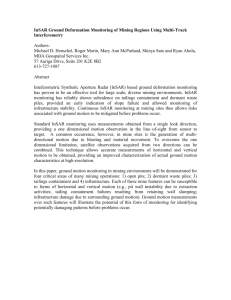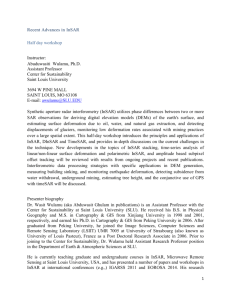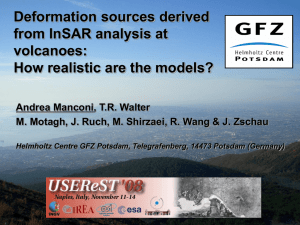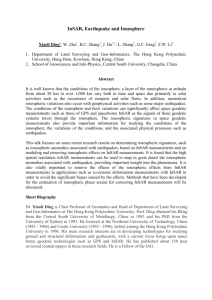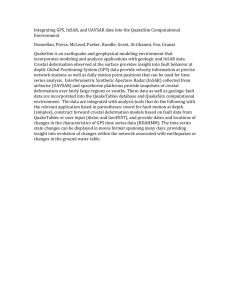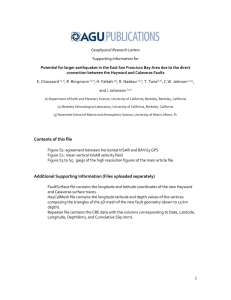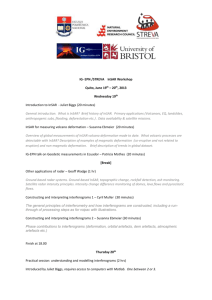InSAR Monitoring of Landslides affecting strategic Transportation Corridors V. Singhroy
advertisement
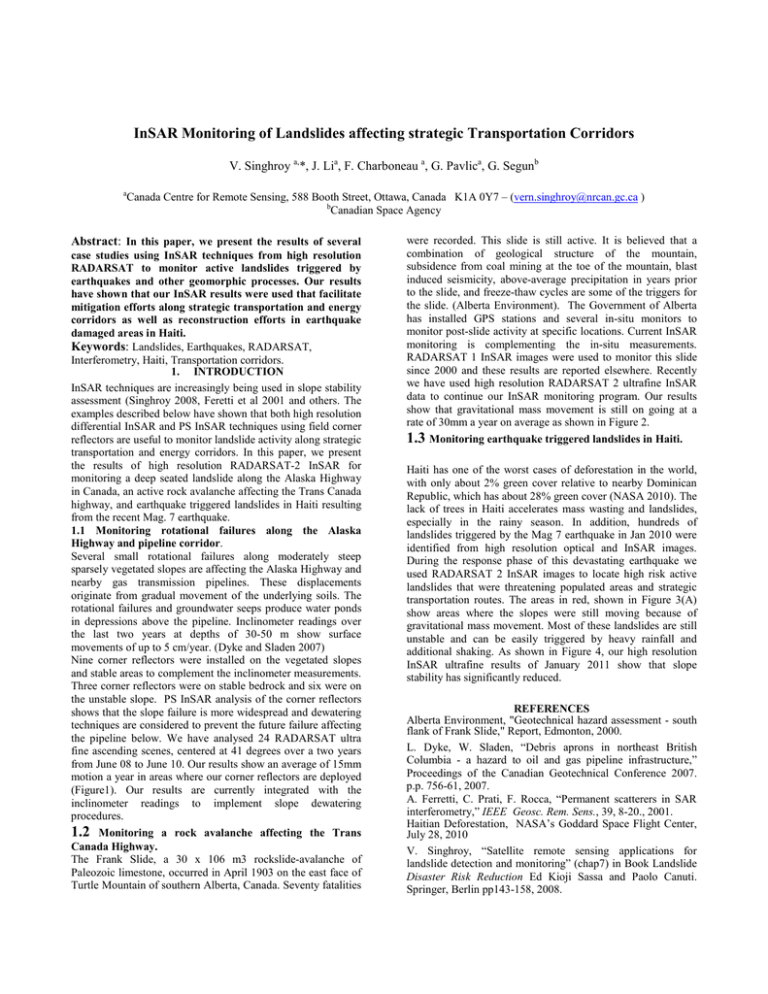
InSAR Monitoring of Landslides affecting strategic Transportation Corridors V. Singhroy a,*, J. Lia, F. Charboneau a, G. Pavlica, G. Segunb a Canada Centre for Remote Sensing, 588 Booth Street, Ottawa, Canada K1A 0Y7 – (vern.singhroy@nrcan.gc.ca ) b Canadian Space Agency Abstract: In this paper, we present the results of several case studies using InSAR techniques from high resolution RADARSAT to monitor active landslides triggered by earthquakes and other geomorphic processes. Our results have shown that our InSAR results were used that facilitate mitigation efforts along strategic transportation and energy corridors as well as reconstruction efforts in earthquake damaged areas in Haiti. Keywords: Landslides, Earthquakes, RADARSAT, Interferometry, Haiti, Transportation corridors. 1. INTRODUCTION InSAR techniques are increasingly being used in slope stability assessment (Singhroy 2008, Feretti et al 2001 and others. The examples described below have shown that both high resolution differential InSAR and PS InSAR techniques using field corner reflectors are useful to monitor landslide activity along strategic transportation and energy corridors. In this paper, we present the results of high resolution RADARSAT-2 InSAR for monitoring a deep seated landslide along the Alaska Highway in Canada, an active rock avalanche affecting the Trans Canada highway, and earthquake triggered landslides in Haiti resulting from the recent Mag. 7 earthquake. 1.1 Monitoring rotational failures along the Alaska Highway and pipeline corridor. Several small rotational failures along moderately steep sparsely vegetated slopes are affecting the Alaska Highway and nearby gas transmission pipelines. These displacements originate from gradual movement of the underlying soils. The rotational failures and groundwater seeps produce water ponds in depressions above the pipeline. Inclinometer readings over the last two years at depths of 30-50 m show surface movements of up to 5 cm/year. (Dyke and Sladen 2007) Nine corner reflectors were installed on the vegetated slopes and stable areas to complement the inclinometer measurements. Three corner reflectors were on stable bedrock and six were on the unstable slope. PS InSAR analysis of the corner reflectors shows that the slope failure is more widespread and dewatering techniques are considered to prevent the future failure affecting the pipeline below. We have analysed 24 RADARSAT ultra fine ascending scenes, centered at 41 degrees over a two years from June 08 to June 10. Our results show an average of 15mm motion a year in areas where our corner reflectors are deployed (Figure1). Our results are currently integrated with the inclinometer readings to implement slope dewatering procedures. 1.2 Monitoring a rock avalanche affecting the Trans Canada Highway. The Frank Slide, a 30 x 106 m3 rockslide-avalanche of Paleozoic limestone, occurred in April 1903 on the east face of Turtle Mountain of southern Alberta, Canada. Seventy fatalities were recorded. This slide is still active. It is believed that a combination of geological structure of the mountain, subsidence from coal mining at the toe of the mountain, blast induced seismicity, above-average precipitation in years prior to the slide, and freeze-thaw cycles are some of the triggers for the slide. (Alberta Environment). The Government of Alberta has installed GPS stations and several in-situ monitors to monitor post-slide activity at specific locations. Current InSAR monitoring is complementing the in-situ measurements. RADARSAT 1 InSAR images were used to monitor this slide since 2000 and these results are reported elsewhere. Recently we have used high resolution RADARSAT 2 ultrafine InSAR data to continue our InSAR monitoring program. Our results show that gravitational mass movement is still on going at a rate of 30mm a year on average as shown in Figure 2. 1.3 Monitoring earthquake triggered landslides in Haiti. Haiti has one of the worst cases of deforestation in the world, with only about 2% green cover relative to nearby Dominican Republic, which has about 28% green cover (NASA 2010). The lack of trees in Haiti accelerates mass wasting and landslides, especially in the rainy season. In addition, hundreds of landslides triggered by the Mag 7 earthquake in Jan 2010 were identified from high resolution optical and InSAR images. During the response phase of this devastating earthquake we used RADARSAT 2 InSAR images to locate high risk active landslides that were threatening populated areas and strategic transportation routes. The areas in red, shown in Figure 3(A) show areas where the slopes were still moving because of gravitational mass movement. Most of these landslides are still unstable and can be easily triggered by heavy rainfall and additional shaking. As shown in Figure 4, our high resolution InSAR ultrafine results of January 2011 show that slope stability has significantly reduced. REFERENCES Alberta Environment, "Geotechnical hazard assessment - south flank of Frank Slide," Report, Edmonton, 2000. L. Dyke, W. Sladen, “Debris aprons in northeast British Columbia - a hazard to oil and gas pipeline infrastructure,” Proceedings of the Canadian Geotechnical Conference 2007. p.p. 756-61, 2007. A. Ferretti, C. Prati, F. Rocca, “Permanent scatterers in SAR interferometry,” IEEE Geosc. Rem. Sens., 39, 8-20., 2001. Haitian Deforestation, NASA’s Goddard Space Flight Center, July 28, 2010 V. Singhroy, “Satellite remote sensing applications for landslide detection and monitoring” (chap7) in Book Landslide Disaster Risk Reduction Ed Kioji Sassa and Paolo Canuti. Springer, Berlin pp143-158, 2008.
